|
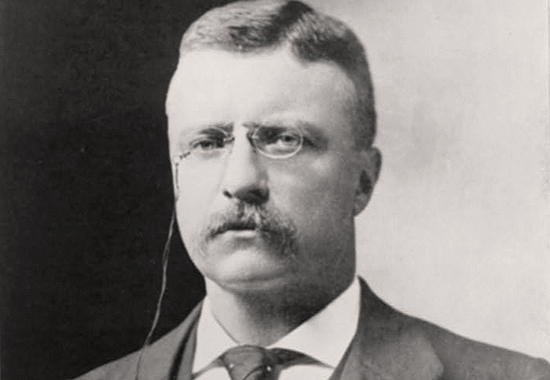
Theodore Roosevelt 1858-1919
Who Was Theodore Roosevelt?
From 1901-1909,
Teddy
Roosevelt was the 26th president of the United States.
|
|
Image Above
Theodore Roosevelt portrait, c. 1900
Library of Congress
He was also a rancher, a historian,
and an author.
Furthermore, Roosevelt was the nation's hero of the
 Spanish-American War of 1898. Spanish-American War of 1898.
|
Teddy Roosevelt was the reason why we call
the White House the White House and, on a slightly more important
note, why we call the Teddy Bear the Teddy Bear.
Theodore Roosevelt was an outdoor man.
Protecting the natural environment, therefore, was one of his
priorities.
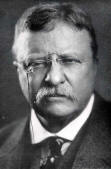
Theodore Roosevelt
The Roosevelt Family
Tree
Here is a
family tree via which you can trace how Theodore,
 Franklin
Delano, and
Franklin
Delano, and
 Eleanor Roosevelt were related.
Eleanor Roosevelt were related.
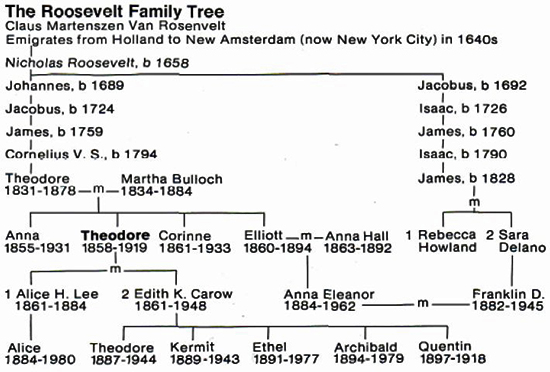
The Roosevelt Family
Tree
NPS
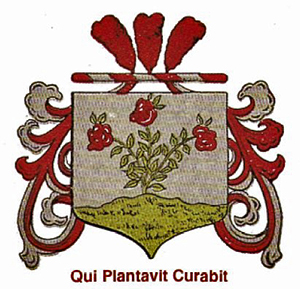
The Roosevelt Arms
NPS
The NPS enlightens us that,
in Dutch,
Roosevelt means Field of Roses.
Thus, the family's coat of arms represents a
rose bush in a green field.
The motto,
Qui Plantavit Curabit, translates He
Who Has Planted Will Preserve.
Theodore Roosevelt — Early Years and Love of Nature
Teddy Roosevelt was originally from New York City. He was born and raised in a brownstone townhouse at 28
East 20th Street in Manhattan, making him the first U.S. president born in New York City.
His upbringing was urban, and he was homeschooled due to chronic health issues, particularly severe asthma.
However, despite his city upbringing and frail health, Roosevelt developed a deep passion for nature and the outdoors
from a very young age. His interest in the natural world began in childhood, when he started collecting animal
specimens and founded the "Roosevelt Museum of Natural History" in his home.
He was especially devoted to birding, kept detailed journals on birds, and published his first work on the birds
of the Adirondacks while still a young man.
Speaking of birding, if you have the Merlin app from Cornell,
then you can aim your phone at the bird
sound, and it will identify the musician for you, including photo and sample sounds. It works
even offline. And it's free. Absolutely fantastic!

This is the Yellow-bellied Sapsucker,
or Sphyrapicus varius if you're a Latinitatis amator,
captured and © by Daniel Jauvin.
Back to Teddy Roosevelt:
Family trips to Europe, Egypt, and the Adirondack Mountains further fostered his love for adventure and the outdoors.
Roosevelt's pursuit of the "strenuous life" was, in part, a response to his health challenges. He undertook vigorous physical
activity, including boxing and hiking, to strengthen his body. These experiences laid the foundation for his later reputation
as an outdoorsman, hunter, and conservationist.
As an adult, he spent significant time in the wilderness, including ranching in the Dakotas and exploring the American West.
His lifelong passion for nature directly influenced his presidency, during which he greatly expanded the national parks and
protected public lands.
Theodore
Roosevelt — Speeches Before His Presidency
On January 26, 1883, in
Buffalo, NY, Theodore Roosevelt gave his speech
 The Duties of American Citizenship.
The Duties of American Citizenship.
On April 10, 1899, Theodore Roosevelt
delivered his
 The Strenuous Life speech at the Hamilton Club in
Chicago.
The Strenuous Life speech at the Hamilton Club in
Chicago.
Theodore
Roosevelt — Presidency
On September 6, 1901, the
25th President of the United States,
 William McKinley, was
shot. McKinley died on September 14, 1901. Later on the same day,
McKinley's Vice President, Theodore Roosevelt, was sworn in. At
forty-two, Roosevelt became the youngest president in the nation's
history.
William McKinley, was
shot. McKinley died on September 14, 1901. Later on the same day,
McKinley's Vice President, Theodore Roosevelt, was sworn in. At
forty-two, Roosevelt became the youngest president in the nation's
history.
What about Teddy Roosevelt's
First Inaugural Address?
There was none.
The Inauguration took place in the
library of the Ansley Wilcox residence in Buffalo, New York. The
residence was located at 641 Delaware Avenue. It was the home of
Ansley and Mary Grace Wilcox, Roosevelt's friends.
There was no Bible used and there was no
public speech. All photographers were kicked out of the room after
one genius knocked over another one's camera equipment.
Roosevelt ended McKinley's term without
having a vice president himself.
On December 3, 1901, and as his
First Annual Message to the Senate and House of Representatives,
Theodore Roosevelt delivered his
 Controlling the Trusts speech.
Controlling the Trusts speech.
On August 16, 1903, Roosevelt delivered
his
 Strength and Decency speech.
Strength and Decency speech.
In 1904,
Theodore Roosevelt started the building
of the Panama Canal.
The Republican Club of the City of New
York invited Roosevelt to speak at their 19th annual Lincoln Dinner
at the Waldorf-Astoria. Celebrated was the 96th anniversary of the
birthday of
 Abraham Lincoln.
Abraham Lincoln.
Theodore Roosevelt accepted the
invitation, and on February 13, 1905, Roosevelt delivered his
 Lincoln Dinner Address. Some also call it the
Lincoln and the Race Problem speech.
Lincoln Dinner Address. Some also call it the
Lincoln and the Race Problem speech.
On March 4, 1905, Theodore Roosevelt
delivered his
 Inaugural Address.
Inaugural Address.
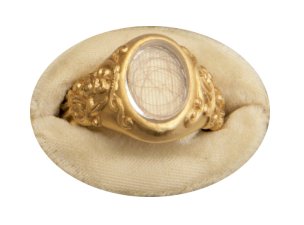
The National Park Service informs us that Teddy Roosevelt wore this
ring, containing pieces of Abraham Lincoln's hair, during his second
inauguration.
Photo: NPS
At the laying of the cornerstone of the Office Building of the House
of Representatives in Washington D.C. on April 14, 1906, Theodore
Roosevelt delivered his
 The Man With the Muck-Rake speech, in which he refers to
the Pilgrim's Progress, a 17th century best-seller
written by the English author John Bunyan.
The Man With the Muck-Rake speech, in which he refers to
the Pilgrim's Progress, a 17th century best-seller
written by the English author John Bunyan.
In 1906, the
 Nobel Peace Prize was his.
Roosevelt received this award for his role in bringing about various peace
treaties that ended the
Nobel Peace Prize was his.
Roosevelt received this award for his role in bringing about various peace
treaties that ended the
 Russo-Japanese War.
Russo-Japanese War.
On January 22, 1909, Theodore Roosevelt
sent a special message to the Senate and House of
Representatives, also called the
 The Conservation of Public Lands message. In this
message,
Roosevelt emphasized the importance of the protection of natural
resources by the government.
The Conservation of Public Lands message. In this
message,
Roosevelt emphasized the importance of the protection of natural
resources by the government.
On April 23, 1910, Theodore Roosevelt
visited the Sorbonne at Paris, France, and delivered his
 The Man in the Arena speech.
The Man in the Arena speech.
The fine people of Osawatomie, Kansas,
were ready for their John Brown Celebration and invited Theodore
Roosevelt to speak on the occasion. Roosevelt accepted and on August
31, 1910, he delivered his
 The New Nationalism speech before approx. 30,000 pairs
of ears.
The New Nationalism speech before approx. 30,000 pairs
of ears.
Go here for more about
 John Brown.
John Brown.
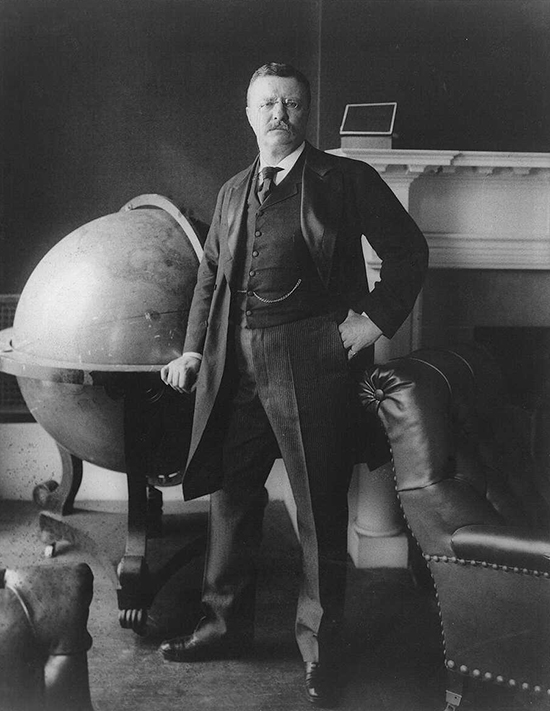
Theodore Roosevelt,
Winner of Biggest Globe Contest, c. February 24, 1903
Library of Congress
Assassination
Attempts on Theodore
Roosevelt
October 14, 1912, Milwaukee, Wisconsin - The following is an excerpt
from the book Just 2 Seconds (Gavin de Becker et al. If you
are in the protection business, a must-read.)
John Schrank followed
Roosevelt for 2,000 miles through eight states in 24 days of
campaigning, waiting for an opportunity to kill him. Roosevelt
walked out of his hotel, got into his open car, and turned to
wave at the crowd.
Schrank fired his .38 Colt revolver
from six feet away. Roosevelt was struck in the right chest,
suffering only a broken fourth rib and a minor wound.
A metal case for carrying reading
glasses and a folded 50-page speech slowed the bullet
substantially, such that Roosevelt was able to complete his
speech. He told the audience, "It takes more than one bullet to
stop a bull moose!"
After the speech, he was taken to
the hospital for treatment. He carried the bullet in his chest
until he died seven years later, of natural causes. Schrank was
tried and spent the rest of his life in prison.
 Check out Assassinations
in History.
Check out Assassinations
in History.
Theodore
Roosevelt's Place in History
Check the
 US Election Map 1796 -
1968.
US Election Map 1796 -
1968.
Check
 Governments in History Chart.
Governments in History Chart.
More History
|